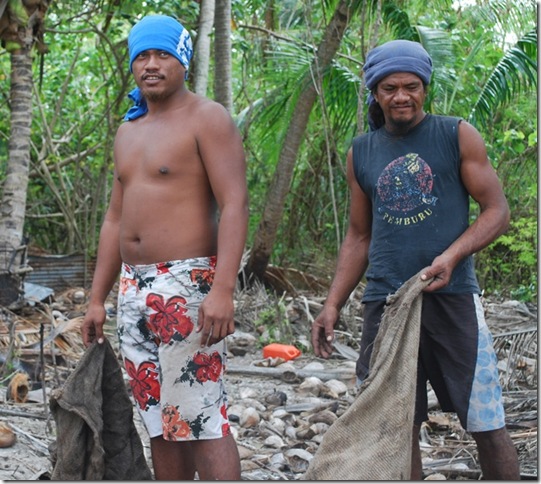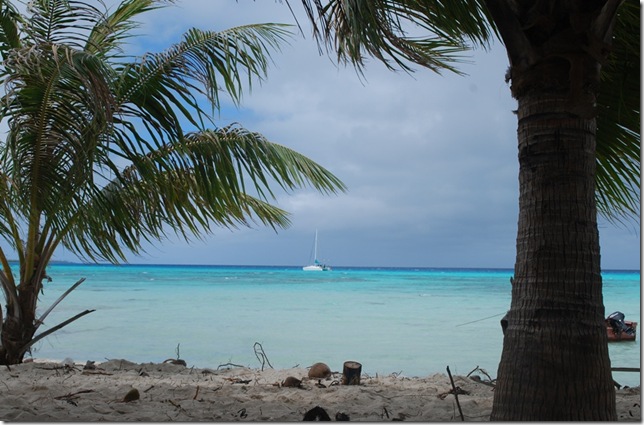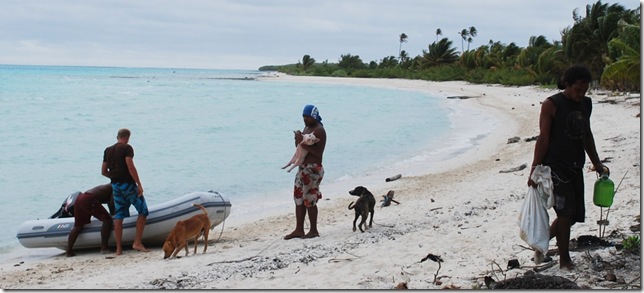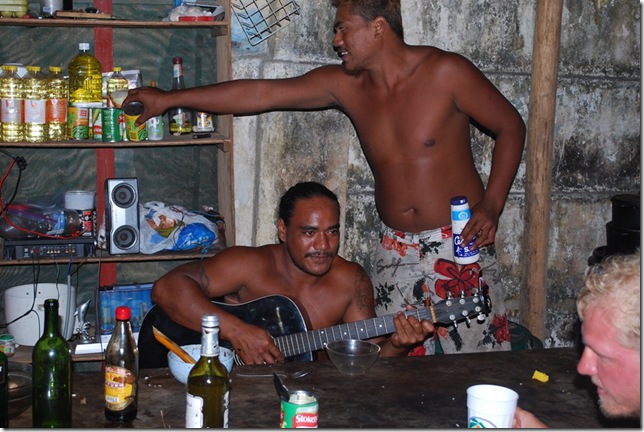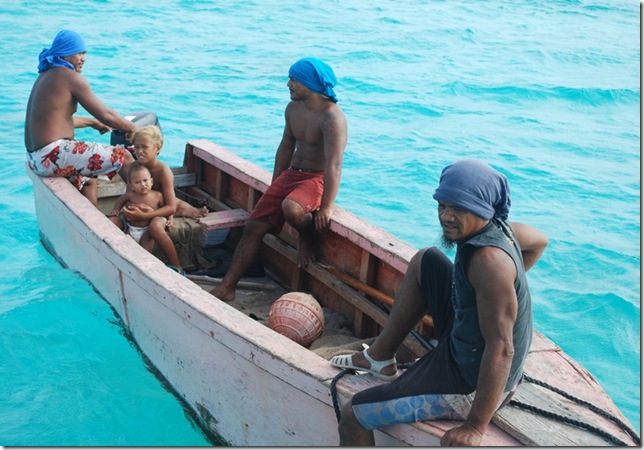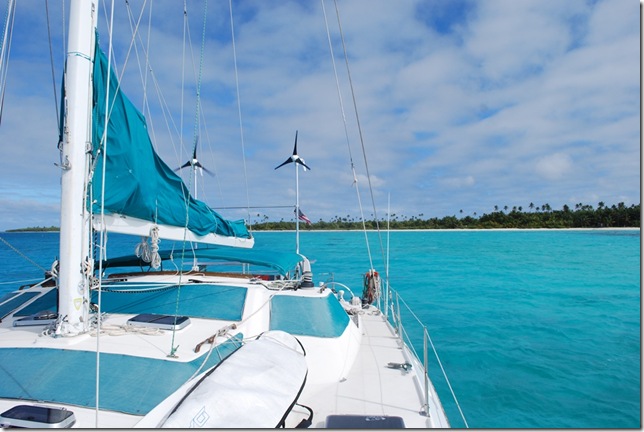Lat: 16 58.034′ S
Lon: 154 30.101′ W
We were awakened yesterday by shouts of “Hello, Bonjour!” I scrambled out to the cockpit and found the guys from the atoll approaching in their boat. They brought four lobsters and three small parrotfish for the second pack of cigarettes. They also asked about some cookies for the kids, but Lauren and I wanted to go ashore anyway, so we told them we’d be in later with some more things.
During breakfast, we downloaded a GRIB file and saw that things would be more pleasant for us offshore if we waited another day to leave, which was just fine with everyone after getting tossed around a bit on the way over.
Mopelia is obviously quite isolated and the mode of life simple, so we tried to pack a decent bag of stuff for them — a couple of shirts, a good pair of work gloves, candles, tea, candy and ribbons for the kids, canned corned beef, WD-40, and some fresh cookies Lauren had made. It’s really nice to be able to give things to people in places like this. When we got ashore, we found a couple of them working on copra by prying the meat from the coconuts. We made introductions and found that this part of the island was inhabited by Kalami (22), his wife Sophie, their two boys (one year and one month, respectively), Kalami’s male relatives Bako (33) and Ruta (25), and an 11-year old son of a friend. They offered us some “locale/Tahitian biere” (did I mention it was 10 a.m.?), which is a concoction they make from rain water, sugar, and yeast. It was very drinkable (tastes like a strong, slightly sweet white wine) and we sat down on a couple of burlap copra sacks to chat. The guys in their 20’s looked about as old as Lauren and I, and at 33, Bako would have passed for a grizzled 48 back in the states, but they were friendly and laid-back.
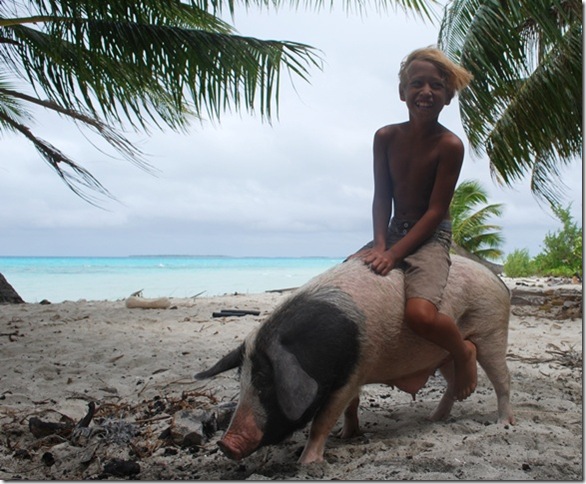 Yes, a pig does move along rather quickly when you reach back and slap it on the behind
Yes, a pig does move along rather quickly when you reach back and slap it on the behind
We were talking on the beach, looking out over the lagoon and at Pura Vida at anchor when it started to sprinkle and we all headed to the house. The house is sort of what you see on television when Sally Struthers is trying to get you to send money to save starving kids. Part of the building was old concrete, but the roof and places that had an outer wall were corrugated tin. There was only one partial inner wall made from a variety of materials that separated the area where Kalami and Sophie sleep. Interestingly enough, they have a couple of solar panels, a deep-cycle battery, and a couple of portable DVD players that also play music as well as an old amp and one above-dash automobile speaker. They were interested in having us burn some CDs for them (UB40, Bob Marley, Bon Jovi, etc.) and before too long they decided we should have a party that night.
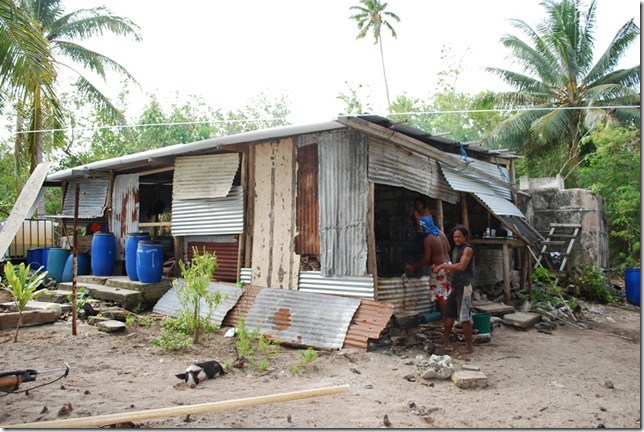 The casa (one of three on Mopelia)
The casa (one of three on Mopelia)
There was another boat anchored out on the reef, and the plan was to invite them to the party as well. The first step was go see Kalami’s Dad to pick up a small pig and some local beer for the party. Ruta and I drew pig and beer-fetching duty, and we headed out. I learned on the way that this meant a boat trip to the far south of the island. As they don’t have much fuel, we were to go in our dinghy. That was no problem, but the dinghy engine has slowly been losing power, and it wasn’t doing well at all. It turns out Kalami’s dad lives at the other end of the atoll, about 4 miles away, and we couldn’t get much above idle power. For some reason, you can rev the motor up, and the prop spins, but there’s no thrust. That’s not covered in the service manual’s two pages on troubleshooting, so it’s going to be a project. Anyway, we eventually decided to turn around and swap boats as we were getting nowhere, and I didn’t want to get stranded.
On the second attempt, we put Kalami’s engine on our dinghy, and we eventually made it. The boat that was anchored out on the reef turned out to be one of the boats we met in Bora Bora, and they were now anchored in the beautiful, peaceful area at the south of the atoll. Ashore, Ruta said hello to Kalami’s parents and set to work. Their place is almost too much to put into words, but imagine a stereotypical rural Appalachian or Arkansas one-room shack, all sorts of modern and primitive items strewn about the yard, a couple of large copra-drying racks, and numerous pigs, dogs, and ducks (first time to see them here). Now superimpose that on a beach and lagoon that Club Med would be drooling over if it wasn’t on an atoll in the middle nowhere. Kalami’s Dad was a chubby, amiable fellow with a big head of curly hair who wore a T-shirt and pair of briefs/speedos, which passes for casual wear on the atolls and takes a bit of getting used to. First, we grabbed a couple of pigs and tied them by the leg to a hammock near the beach. One was larger than the other, but both were small and white. We also grabbed a sort of grill to cook the pigs and Ruta filled the bottles we brought with the local beer. Kalami’s Dad makes the stuff in a big water barrel and also had some bananas in this batch. In typical island style, the bottles are any glass bottle or jug that’s been left or found, especially wine bottles. For corks, there’s a type of foam fishing buoy hanging from the re-bar protruding from the roof that can be cut and stuffed into the neck of the bottle.
We loaded the pigs, grill, and a pretty fair amount of the “locale biere” into the dinghy and finally arrived back several hours after we’d originally left. I’d inadvertently left Lauren there for several hours, but she managed well, getting to know the family. They receive a visit from about three trading boats a month from nearby Maupiti. They keep a number of pigs and there are also wild pigs on the island, so they trade pigs for cigarettes, baby food, and other commercial goods. They also get about 3 cruising boats a week during the season (an additional item we picked up at at Kalami’s father’s place was a guestbook filled with entries from visiting yachts). There’s essentially no money on the island, and they prefer the subsistence and trading existence to the monetary and labor economy. They have plenty of fish and meat, and grow a few vegetables as well. Lauren also learned how to make coconut milk, which has been something we’ve wanted to figure out. The key is to get a young coconut and the proper tool. They use a device that looks like a paddle with a scraper at the end of the handle. You sit on the fat part and use the scraper between your legs to clean the soft meat from a young coconut. The meat can then be wrung out using a cheesecloth to produce the milk that’s used for dishes like poisson cru.
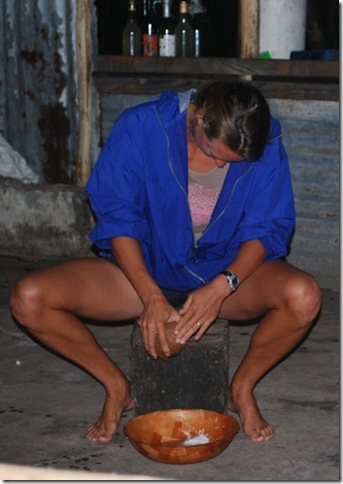 Lauren grating the meat out of a young coconut
Lauren grating the meat out of a young coconut
Dinner that night consisted of barbecued ribs, poisson cru, rice, and a second pork dish (I’m not sure which pig was ribs and which was stew, but Lauren says they were both good as long as someone else is doing the presto-change-o). For me, they even broke out a can of corn. Before we could get started eating, though, we had to make a quick run back to the boat for place settings for Lauren and I. As they were drinking from old wine bottles and bowls it doesn’t appear they have cups, and they didn’t have any extra plates or forks. No worries, as we’d forgotten my guitar as well.
After dinner the singing started. It turns out Ruta is an incredibly good guitar player even though he doesn’t own one and hasn’t touched one for 5 months. In addition to Tahitian and French songs, he played Bob Marley, Metallica, improvisations, and did some pretty impressive picking. Everybody joined in, and Ruta even got me to attempt some improvised vocals, which isn’t something you’ll be hearing anytime soon. There were songs about everything from my love / mon cherie to Jacque Chirac, to the moon and the pass, but Lauren and I almost died laughing when they all of a sudden started singing the French version of Hakuna Matata from the Lion King. Ruta was pretty impressed with the guitar and offered all the lobster in Mopelia for it. Unfortunately, I’m a vegetarian and we don’t have a freezer now, so we all had a good laugh at that being unfortunate for him. Because of the issues with our motor, Kalami and Bako took us back using their boat at the end of the night. The route is littered with shallow water and large coral heads, so we used a large light we had and left it with them to get back safely.
This morning, Kalami returned with the light and guestbook for us to sign (they hadn’t had a pen at the house the night before) and I gave him a few more things, including a low-power, guaranteed-for-life LED light that should help out a bit in the home lighting department. It seemed like we were both sad to say goodbye, but such is our life. The sun had come out and the wind had lightened up a bit, making our weather planning seem worthwhile. Tiff cooked up the lobsters and we enjoyed lunch before pulling up the anchor and motoring across the lagoon.
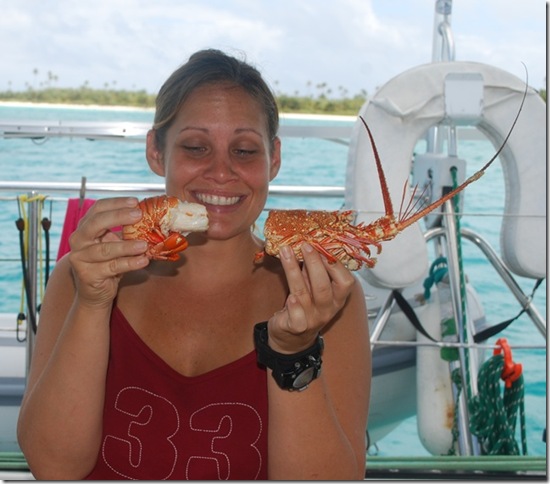 Et Voila! 1/4 of a pack of cigarettes worth of lobster
Et Voila! 1/4 of a pack of cigarettes worth of lobster
This place is so beautiful that we all just sat on deck and watched silently as we made our way toward the pass. Before we knew it, we were through the pass and out into open water. Tiff pulled down the French courtesy flag, and our visit in French Polynesia officially came to an end. It was a wonderful last stop and one that we’ll remember for a long time. Lauren looked through the guestbook and noticed that several boats had returned to Mopelia a second time after several years, and there’s no doubt we’d do the same if we came this way again.
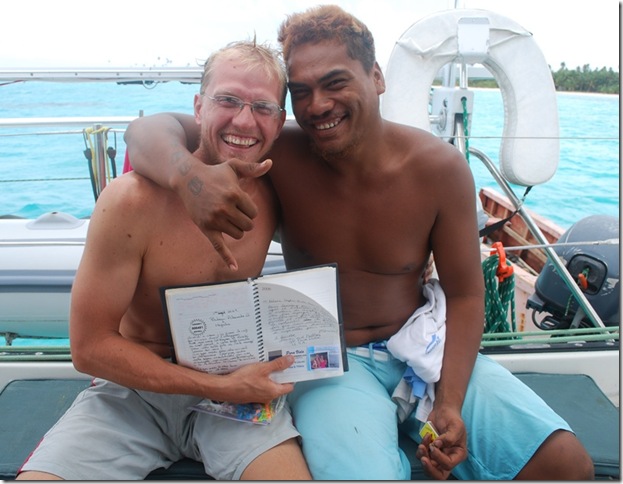 Our page in the Mopelia guestbook
Our page in the Mopelia guestbook
The seas are still up a bit, but not as bad as they were, and the sun is out, making it a beautiful day for sailing. We’re using just the jib again and are averaging above 5 knots with no problems.
Lat: 16 46.738′ S
Lon: 153 56.869′ W
Lauren and I started our last full day in Bora Bora with a snorkel trip to the “coral garden” around the point. I stayed at the surface on account of my ear, which has shown no improvement, but was able to enjoy things nonetheless. The coral wasn’t much to see, but there were a lot of colorful smaller fish that are evidently used to being fed, as many of them swarmed around us. There were also several schools of a light-colored fish that were laying in groups on the bottom, like they were having an afternoon nap. I’m still a little bummed about being diving-disabled in Bora Bora, but as Dr. Duval pointed out, I can’t complain too much, as there should be plenty of other dive opportunities.
Next we headed into town to do some shopping, including buying duty-free diesel, one of the few reasonably priced items to be found here. When we got to the fuel dock in the dinghy with our fuel jugs, we found a boat from the anchorage we’d just left along with a friend of theirs with a dinghy full of fuel jugs. The woman’s first question to Lauren was, “Does Dallas have the correct papers for the duty free fuel?” Evidently we’ve been fortunate in that even though the authorities in Papeete were feuding as I stood there, they managed to give me all the correct papers, unlike some other people we’ve meet. The other cruisers at the dock were missing one of the 4 papers that are required (the duty-free diesel permit alone isn’t enough), so I ended up using my papers to buy fuel for all of us.
Next we were off to the marine store to pick up a handheld VHF. One of ours was stolen from Lauren’s backpack in the Galapagos (where they retail for about $400) and our second one just died, which makes sharing a dinghy a little difficult. We also made the obligatory stop at the grocery store to stock up and grab some snacks and stopped at the hardware store for some boat project items.
Duty-free diesel is only about $3/gal, which feels like next to free, so the next morning, after topping off with water and emptying trash at the Bloody Mary’s dock, we headed back to the fuel dock to fill our jugs again, as all the diesel we’d bought the day before had been put into the tanks. This was our third visit to the gas station, and the woman who was a bit short and speaking French-only the first time we came and didn’t have enough cash was now very friendly, broke out reasonable English, and volunteered to combine our diesel purchases from the last couple of days so we didn’t have to do more paperwork. It really helps to smile and know how to say hello in the local language (“Yo-rana”). Our diesel tanks are now topped off and we have extra fuel in the jugs.
There are a couple of things I thought were interesting about Bora Bora that haven’t made it into a blog yet. One is that having reached the end of French Polynesia, we have yet to see a Polynesian wearing eyeglasses. We asked Moana about it in Ua Pou and he seemed to indicate that Polynesians had genetically good eyesight. I’ve mentioned it to another cruising couple and they couldn’t recall ever seeing a Polynesian with eyeglasses either. Another thing that seems to be unique to Bora Bora are go-fast boats with a complete disregard for anchored sailboats. The private boats and dive boats will buzz through an anchorage at a pretty high speed, sometimes within one boat length of anchored boats, which gets a little frustrating if you’re in the water working on the boat or in the middle of something that doesn’t like to be shaken up. Apparently because of all of the clear water and visible rocks and coral heads, the speedboats here have a unique design. Instead of sitting in the back of the boat, the driver sits on a seat in the bow of the boat and steers with a lever that moves left and right. Presumably, the forward helm station makes it easier to see the path that should be steered, but it’s the first time I’ve seen a design like that.
We weren’t the only boat that picked this window to leave. The VHF was crackling with boats hailing each other to check on conditions, arrange radio rendez-vous, and wish each other good trip. As we headed out the pass and set our sails, we could see at least five other boats heading out for different points west. Even in a gathering spot like Bora Bora, that feels like a virtual armada of cruising boats setting out.
We set a course for Mopelia, a small atoll we learned about from Jerome and Antoine while we were in Kauehi. It has the narrowest, supposedly most nerve-wracking pass in French Polynesia and is inhabited by between 3 and 20 people at a time.
The weather forecast called for moderate winds, followed by shifting light winds, before filling in from the southeast. Everything worked out as forecast, but we got a bit more wind and steep seas on the beam than we were expecting after things filled in during the early morning hours. Lauren did a good job on her watch of stowing all of the fuel and water jugs that had been sitting on the side decks and doing their best to jump overboard when things started getting rough. All of us pretty much stayed horizontal unless we had to get up, but nobody got sick enough to do any fish feeding. With her typical iron stomach, Lauren of course managed to do a bit of cooking (telling me later about picking the dead weevils out of the pasta) and some reading.
Between motoring in the light winds and doing 6 knots on just the jib when the wind picked up, we made the 128 nm run to Mopelia in time to attempt the pass at an ideal time, with the sun at our backs to make it easier to see and avoid coral heads. For the first time ever, our Navionics charts were off. When I lined up to head into the narrow, churning pass, the charts showed us going straight onto the reef, with the pass off to port. Oh well, this isn’t exactly a hotbed of yachting activity and you’ve got to trust your eyeballs, especially with a pass like this. The pass has quite a reputation, and it is narrow (maybe 60 ft or so and we have a beam of 21 ft), with lots of current (we got lucky and only had about 3-4 knots or so) and jagged coral rock edges, but it’s deep enough, and we made it through only a few tense minutes after we made the irreversible commitment to go for it. Lauren and Tiff each kept a look out for rocks from the bows and I kept busy with the throttles up and the wheel spinning back and forth as each refracted wave tried to turn the boat.
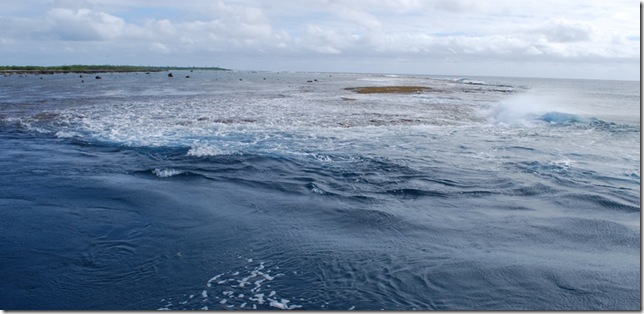 Current, rocks, and small breakers entering the pass
Current, rocks, and small breakers entering the pass
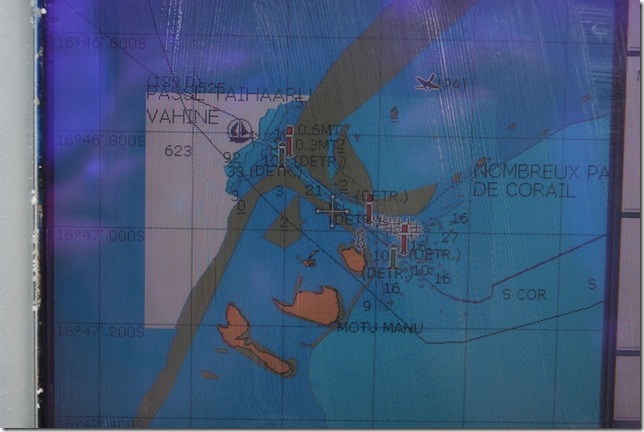 The bottom track shows the actual pass location
The bottom track shows the actual pass location
The atoll itself is incredibly beautiful. It is just a bit larger than 3 miles by 4 miles and sets NNW-SSE along the long axis. It has several motus, including a very large one that makes up the eastern side of the lagoon. A couple of the motus have small raised hills with greenery and coconut trees, while nice sandy beaches, and turquoise and soft blue water are everywhere. From our anchorage here on the northeast portion, we can see the spray thrown high up into the air as the swell crashes on the southern fringing reef 4 miles away. One of the motus is supposed to be a bird nesting site and the boat was surrounded by about a dozen large sea birds circling and swooping down near us as we approached the atoll.
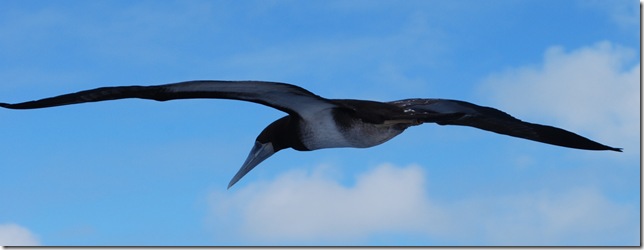 These guys were everywhere on the way in
These guys were everywhere on the way in
By the time we’d anchored and gotten settled, it was getting a bit close to dark for a shore visit, but we could see pigs wandering on the beach near a shack and home-built boat. Before long, a couple of guys got into the boat and headed our direction. They slowed near our stern and handed me two gutted, ready-to-eat parrotfish in a pan. The boat they came out on was a long and narrow home-built work boat with an outboard motor. Mounted on the bow was a nice sailing winch that they’d salvaged from a catamaran that is apparently wrecked on the reef near the pass. We’d heard that supply ships are pretty scarce here and that cigarettes are highly valued. Although none of us are smokers, Lauren and I had picked up a couple of packs before leaving Bora Bora. You should have heard the yelling and hollering that broke out when I told them we had cigarettes to trade for the fish. It was like they’d won the lottery. Tomorrow morning they’re bringing out lobster for the second pack. We asked how many people lived on the island, and they said two families. When we asked how many people that included, there was some finger-counting, a sort of confused look, and then we moved onto the next question.
Tiff did a great job preparing and cooking the fish, and we incorporated it into a fish burrito dinner that Wahoo’s would be proud of. There’s only one light on the island, barely visible for a couple of hours after sunset, coming from the dwelling on the beach that we saw earlier today. Other than that, it’s an overcast night and it would be hard to tell we were anchored all alone in a lagoon at all just by looking around.
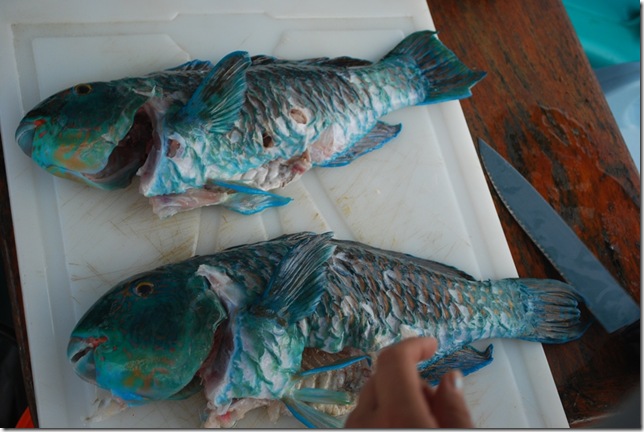 Parrot fish (in addition to the colors, the mouths really are like beaks)
Parrot fish (in addition to the colors, the mouths really are like beaks)
We’re probably headed out tomorrow to try to get to Aitutaki by the weekend, but this is definitely one of those virtually untouched places where it’s easy to linger and just take in the peace and natural beauty.


